

Components of an Ecosystem : Biotic and Abiotic


Components of an Ecosystem
The components of the ecosystem are categorized into abiotic or non-living and biotic or living components. Both the components of the ecosystem and environment are the same.
1. Abiotic Components
Abiotic components are the inorganic and non-living parts which act as major limiting factors.
Light
- The spectral quality of solar radiation is important for life.
- The UV component of the spectrum is harmful to many organisms.
Rainfall
- Majority of biochemical reactions take place in an aqueous medium.
Temperature
- A few organisms can tolerate and thrive in a wide range of temperatures (they are called eurythermal).
- A vast majority of them are restricted to a narrow range of temperatures (stenothermal).
Atmosphere
- 21% oxygen helps in the survival of many organisms; 78% nitrogen prevents spontaneous combustion and 0.038% carbon dioxide helps primary producers in the synthesis of carbohydrates.
Organic compounds
- Proteins, carbohydrates, lipids etc. are essential for energy transfer in the living world.
Inorganic compound
- e Carbon, carbon dioxide, water, Sulphur, nitrates, phosphates, and ions of various metals are essential for organisms to survive.
Altitude
- Vertical zonation of vegetation is caused due to altitude.
- Change in temperature with altitude is a limiting factor.
Buffering capacity of the earth
- A neutral pH (pH of 7) is maintained in the soil and water bodies due to the buffering capacity of earth.
- The neutral pH is conducive for the survival and sustenance of living organisms.
Salinity
- Some organisms are tolerant of a wide range of salinities (euryhaline).
- Others are restricted to a narrow range of salinities (stenohaline).
2. Biotic Components
Primary producers or Autotrophs (self-nourishing)
- Primary producers are green plants, certain bacteria and algae that carry out photosynthesis.
- In the aquatic ecosystem, microscopic algae (plankton) are the primary producers.
Consumers or Heterotrophs or Phagotrophs (other nourishing)
- Consumers are incapable of producing their own food.
- They depend on organic food derived from plants, animals or both.
- Consumers can be divided into two broad groups namely micro and macro consumers.
Macro consumers
- Herbivores are primary consumers which feed mainly on plants. E.g. sheep, rabbit, etc.
- Secondary consumers feed on primary consumers. E.g. wolves, dogs, snake, etc.
- Carnivores which feed on both primary and secondary consumers are called tertiary consumers. E.g. lion (can eat wolves), snakes etc.
- Omnivores are organisms which consume both plants and animals. E.g. man, bear, pig, etc.
Micro consumers or Saprotrophs (decomposers or osmotrophs)
- They are bacteria and fungi which obtain energy and nutrients from dead organic substances (detritus).
- Earthworm and certain soil organisms (such as nematodes, and arthropods) are detritus feeders and help in the decomposition of organic matter and are called Detritivore.
IMPORTANT LINK
- What is Meaning of Analysis of Financial Statement? Its objectives and importance
- IMPORTANCE AND LIMITATIONS OF FINANCIAL STATEMENTS
- Meaning and Definitions of Financial Statement | Nature of Financial Statements | Characteristics of an Ideal Financial Statement
- What is the scope of management accounting?
- Procedure of Financial Statements Analysis
- Comparative Financial statement Analysis | Advantages of Comparative Financial Statements | Limitations of Comparative Financial Statements
- IMPORTANCE AND LIMITATIONS OF TREND ANALYSIS IN HINDI
Disclaimer: quizsansar.com does not own this book, PDF Materials Images, neither created nor scanned. The material and information contained on this website is for general information purposes only. If you have a complaint about something or find your content is being used incorrectly then kindly mail us: sansarquiz@gmail.com


2 Types of business environment : Internal and external environment


Types of business environment
The environment in which an organization exists can be broadly divided into two parts –
1. Internal environment
Internal factors are those factors which a business has acquired or which can be acquired by a business according to its requirements and capacities, internal factors determine the level of operation. Following factors are included in internal factors.
(a) Financial resources – The financial resources indicate to what extent the firm can make commitment to business activities? What would be the level or production? What should be the level of production? It is directly influenced by the availability of funds, expenditure control are of crucial importance in every organization. A business firm should try its best to make the maximum utilization of its financial resources. If funds are not utilized economically and in profitable process they are transferred to some other process. The loss of business from process.
(b) Physical resources – Physical resources of a business comprise following assets such as plant machinery, land and building, raw materials etc. regular supply or raw materials is necessary for smooth functioning of a business unit. Factory should be established at a place where physical resources are easily available.
(c) Technical resources – The state of technology at any one time is an extremely important factor affecting the success of any business. Any business that wishes to survive in the ever changing world must keep abreast of technology applicable to its precuts and services and to its methods of operations. A business unit determines the level of technology for the operation of activities. Business firm can develop its own technology or it can acquire from the market.
(d) Human resources – Human resource helps the organization to much factors are closely interrelated. Human resource helps the organization to much its man power with skills necessary for achieving its objectives.
2. External environment
External environment refers to external aspects of environment which have influence on the functioning of business. External environment is very crucial for the success of a business. The external environment consists of customers, competitors, government policies; society etc. following factor are included in external environment.
(i) Customers – Demand for products and services has great impact on the reaction of the customers. Customers and business are interdependent. The aim of business is to create and retain customers. To succeed in capturing customers, a business must collect the information regarding demand for product, liking and disliking of customers, customers expectations from the product, their purchasing power. A business has closely monitor and analyse changes in customers tastes and preferences and their buying habits, as the major task of a business is to create and retain customers, monitoring the customer’s sensitivity is a prerequisite for the business success.
(ii) Competitors – A firm’s competitors include the other firms which market the same or similar products and also those who compete for the discretionary income for the consumers. For the existence and survival, a business must be aware of strengths and weaknesses of the competitors. For example, the market strengths of competitor will provide guideline to another business unit in formulation its sale plans. A business undertaking should analyze the price determined by the competitors. Conditions and rule of sale, after sale services before a formulation its policies.
(iii) Government – Business is directly guided and controlled by government policies. Government rules and regulations related with control and economic policies may determine the area in which private sector may entre. For the centralization of industries in specific place and area, the government may provide tax concessions, economic assistance and financial incentives.
(iv) Society – A business exists within a social system and gets facilities from it. They owe obligations for the society as a whole. It is the obligation of management to protect the interest of society. A business undertaking should produce goods and services according to the tastes and preference of the customers. A business should function according to the expectation of the society.
IMPORTANT LINK
- What is Meaning of Analysis of Financial Statement? Its objectives and importance
- IMPORTANCE AND LIMITATIONS OF FINANCIAL STATEMENTS
- Meaning and Definitions of Financial Statement | Nature of Financial Statements | Characteristics of an Ideal Financial Statement
- What is the scope of management accounting?
- Procedure of Financial Statements Analysis
- Comparative Financial statement Analysis | Advantages of Comparative Financial Statements | Limitations of Comparative Financial Statements
- IMPORTANCE AND LIMITATIONS OF TREND ANALYSIS IN HINDI
Disclaimer: quizsansar.com does not own this book, PDF Materials Images, neither created nor scanned. The material and information contained on this website is for general information purposes only. If you have a complaint about something or find your content is being used incorrectly then kindly mail us: sansarquiz@gmail.com


5 Main Components of business Environment


Main components (Micro & macro) of business environment
The main components of environment are as under-
1. Economic environment (micro environment)
A business enterprise draws certain inputs for the production from the society and transmits them into the external environment as finished products. Following factors are included in economic environment.
(I) Suppliers of inputs – Every business enterprise draw physical, human and financial resources from the environment. The importance of reliable sources for supply is an important force in economic environment of a company and is necessary for the smooth functioning of the business.
(II) Customer – A customer may be defined as a person who as person has a favourable impression of the company and its products and services. A business enterprise owes a primary obligation to give fair deal customers. They should be charged a fair and reasonable price. The supply of goods and services should be of uniform standard and of reasonable quality.
The distribution of goods and services should be wide spread so that customers do not face any problem in procuring them. The business enterprise should not mislead the customers by false misleading and exaggerated advertisements.
2. Political environment
The economic policy of the government has a great impact on business. A restrictive import policy or a policy for protecting the home industries may help the export competing industries, while a liberalization of the industries may create difficulties for them, similarly an industry that falls within the priority sector in terms of the government policy gets a number of incentives and other positive support from the government, whereas those industries which are regarded as inessential may have the adds against them. An industries undertaking may take advantage of external economies by location itself in a large city but the government may discourage location in such places and persuade industries to go to the backward areas.
3. Social environment (macro environment)
This is too general a entity which influence almost all enterprises in a similar manner. It is a complex of factors such as social traditions, values and beliefs, standard levels of literacy and education, the ethical standards and state of society. the extent of social satisfaction, conflict and cohesiveness and so forth From the business organization’s point of view, it may include the following:
(i) Population trends – Population trends like the size, growth rate, age composition, sex composition etc. of the population, family size, the size of the population, population level, care, relation etc. are all relevant to business. The sizes of the population, population growth rate, age composition, life expectance, family size, occupation status, employment pattern etc. affect the demand for goods and service.
(II) Individual needs – An individual works to satisfy his physical needs like good, cloth and shelter. But a person wants more that his personal needs. He wants more cooperation in work planning. In traditional occupations, decision making is centralized at top level of management. In decision making process employees and workers should also be involved. It would check the mobility of labour.
(III) Cultural factors- Cultural environment consists of factors related to human relationship and the impact of social attitudes and cultural values which has bearing on the business of the organization. The belief, value and norms of a comity determine how individuals and organizations should interrelated. The core beliefs of a particular society tend to the persistent. It is difficult for business to change because these core values, which become determinates of its functioning.
The cost of ignoring his customs, traditions, taboos, tastes and preferences etc. of people could be very high. The buying and consumption habits of the people, their language, beliefs and values, customs and traditions tastes and preferences, education etc. affect business.
4. Legal environment
In business, legal environment is the branch of political environment. The type of government running a country has a powerful influence on business. Political and pressure groups influence and limit organizational growth. The business in our country is regulated by following-
- Contract Act.
- The Companies Act.
- Foreign Exchange Management Act.
- Factories Act.
- Industries disputes Act.
- Workers Compensations Act.
- Industrial Development and Regulations Act.
- Minimum Wages Act.
- Essential Commodities Act.
- Income Tax, Excise duties, Custom duties, Tariff, Sales tax and other laws related to tax.
- Employee’s Provident Fund Act.
- Consumer Protection Act.
- Employee’s State Insurance Act.
- Environment Protection Act.
- Sick Industrial Company Act.
5. Technological environment
Technology has changed the way of people communicates with the advent of internet and telecommunication system. Technology has changed the ways of low business operates now.
The technology and business are giggly inter-related and inter dependent also. The fruits of technological research and development are available to society through business only and this also improves the quality of life of the society.
IMPORTANT LINK
- What is Meaning of Analysis of Financial Statement? Its objectives and importance
- IMPORTANCE AND LIMITATIONS OF FINANCIAL STATEMENTS
- Meaning and Definitions of Financial Statement | Nature of Financial Statements | Characteristics of an Ideal Financial Statement
- What is the scope of management accounting?
- Procedure of Financial Statements Analysis
- Comparative Financial statement Analysis | Advantages of Comparative Financial Statements | Limitations of Comparative Financial Statements
- IMPORTANCE AND LIMITATIONS OF TREND ANALYSIS IN HINDI
Disclaimer: quizsansar.com does not own this book, PDF Materials Images, neither created nor scanned. The material and information contained on this website is for general information purposes only. If you have a complaint about something or find your content is being used incorrectly then kindly mail us: sansarquiz@gmail.com


What is meant by business environment ?


What is meant by business environment ?
Meaning and Definitions of Business Environment
Business environment means the aggregate of all those factors, conditions, situations which directly affect the working of a business organization. The term business environment has been defined by the various authors as follows –
(1) According to William S. Lawrence, “The environment includes factors outside the firm which can lead to opportunities or threats to the firm. Although there are many factors, the most important of these factors are socio-economic, technological, suppliers, competitors and government.”.
(2) According to Prof. Weimer, “Business environment encompasses the climate or set of conditions – economic, social, political or institutional in which business operations are conducted.”
(3) Keith Davis opined, “Business environment is the aggregate of all conditions, events and influences that surround and affect it.”
Conclusion: It may be said that the external factors which affect the working of a business is called ‘business environment’. The working of a business is influenced by economic or non-economic environment. Domestic and all economic factors, events and policies which affect economics are all economic environmental factors. The non-economic factors are social environment, political environment and policies environment and legal environment.
IMPORTANT LINK
- What is Meaning of Analysis of Financial Statement? Its objectives and importance
- IMPORTANCE AND LIMITATIONS OF FINANCIAL STATEMENTS
- Meaning and Definitions of Financial Statement | Nature of Financial Statements | Characteristics of an Ideal Financial Statement
- What is the scope of management accounting?
- Procedure of Financial Statements Analysis
- Comparative Financial statement Analysis | Advantages of Comparative Financial Statements | Limitations of Comparative Financial Statements
- IMPORTANCE AND LIMITATIONS OF TREND ANALYSIS IN HINDI
Disclaimer: quizsansar.com does not own this book, PDF Materials Images, neither created nor scanned. The material and information contained on this website is for general information purposes only. If you have a complaint about something or find your content is being used incorrectly then kindly mail us: sansarquiz@gmail.com
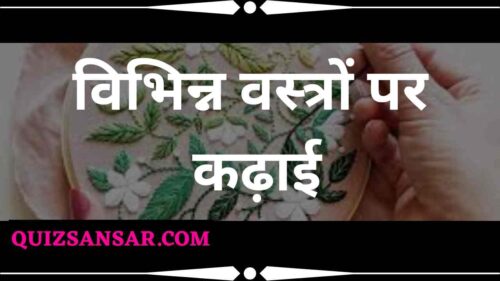

विभिन्न वस्त्रों पर कढ़ाई


विभिन्न वस्त्रों पर कढ़ाई
घर में कढ़ाई मेजपोश, पलंगपोश, ट्रे-कवर आदि वस्त्रों पर की जाती है। इनके अतिरिक्त कुछ पहनने के वस्त्रों, जैसे— पेटीकोट, साड़ी, ब्लाउड, रूमाल आदि पर भी कढ़ाई का कार्य किया जाता है। कढ़ाई द्वारा वस्त्रों को सुन्दरता प्रदान की जाती है। अतः इस उद्देश्य की दृष्टि से डिजाइन व रंगों का उचनाव बुद्धिमत्तापूर्ण होना चाहिए। इनके अतिरिक्त आज के युग में प्रत्येक व्यक्ति विभिन्न कार्यों में व्यस्त रहता है, इसलिए समयाभाव के कारण डिज़ाइन ऐसे चुने जायें जो छोटे हों तथा जिनके काढ़ने में कम समय और कम धागे का प्रयोग हो परन्तु अधिकाधिक आकर्षक हों। यहाँ अधिक उपयोग में आने वाले कुछ कपड़े पर कढ़ाई करने के सम्बन्ध में कुछ बातें दी जा रही हैं-
मेजपोश –
मेजपोश किसी ऐसे मोटे व सूती कपड़े का होना चाहिए जिसे आसानी से धोया जा सके। इसके लिए लिनेन, केसमेण्ट तथा खद्दर सर्वोत्तम है। लट्ठे और पोपलीन का मेजपोश बनाया जा सकता है। कमरे की रंग-व्यवस्था के अनुसार ही मेजपोश के रंग का चुनाव करना चाहिए। मेजपोश का आकार मेज के अनुसार होना चाहिए। परन्तु यह ध्यान रखा जाये कि मेजपोश मेज से लगभग 15 सेंटीमीटर चारों ओर लटकता हुआ होना चाहिए। मेज का डिजाइन आवश्यकतानुसार बीच में अथवा किनारों पर काढ़ा जा सकता है। उदाहरणार्थ, मेजपोश पर जो रेडियो की मेज पर बिछाने के काम आता है, डिजाइन कोने पर होना चाहिए। मोजपोश के किनारे क्रॉस-स्टिच (Cross stitch), फैदर, स्टिच (Feather stitch), ब्लैकेट स्टिच (Blanket Stitch) तथा चेन स्टिच (Chain stitch) आदि से सुशोभित किये जा सकते हैं। किनारों पर सफाई से लगायी गयी लेस व पाइपिंग भी सुन्दर लगती है। मेजपोश पर काढ़ने के कुछ डिजाइन के नमूने दिये गये हैं जो कम समय में आसानी से विभिन टाँकों के द्वारा काढ़े जा सकते हैं और देखने में भी आकर्षक लगते हैं।
ट्रे तथा टीकोजी कवर—
ट्रे कवर भी गोल आयताकार, चौकोर, अण्डाकार आदि आवश्यकतानुसार बनाये जाते हैं। इनके लिए डिजाइन ट्रे तथा टीकोजी के आकार के अनुसार ही होना चाहिए।
ट्रे तथा टीकोजी कवर के लिए लिनेन, केसमेण्ट तथा खद्दर ही अधिक उपयुक्त होते हैं क्योंकि इनमें विभिन्न रंग मिल जाते हैं तथा आसानी से धोये जा सकते हैं। इनके कवर का रंग खाने के कमरे की रंग व्यवस्था के अनुकूल होना चाहिए। इनके कुछ नमूने यहां दिये गये हैं।
खाने की मेज तथा श्रृंगार की मेज के नेपकिन (Luncheon and Duchess Set)—
आजकल खाने की मेज पर प्लेटों के नीचे रखने के लिए लगभग 4×3 मीटर आकार के सुन्दरतापूर्वक कढ़े हुए कपड़े के टुकड़े उपयोग में लाये जाते हैं। इसी प्रकार श्रृंगार की मेज की सजावट तथा सफाई के लिए लगभग 22×38 सेमी. आकार के टुकड़े प्रयुक्त किये जाते हैं। आवश्यकतानुसार इन नापों में परिवर्तन किया जा सकता है। खाने की मेज के लिए साधारणतः 7 टुकड़ों का सैट बनाया जाता है। इनमें से 6तो ऊपर लिखे नाप के तथा एक 40×25 सेमी. का टुकड़ा मेज के बीच में बिछाने के लिए काम में लाया जाता है। इसको सेन्टर मैट (Centre mat) कहते हैं।
कढ़ा के कुछ डिजाइन निम्न प्रकार के हो सकते हैं तथा उनको काटने के लिए विभिन्न टाँके प्रयोग में लाये जा सकते हैं।
- 1, 2, 3, 4 = उल्टी बखिया
- 5,6 ― छोटा-बड़ा टाँका
- 7 ― जंजीरा टाँका
- 8, 9 ― बँटा हुआ जंजीरा टाँका
- 10 ― सीधा टाँका
- 11―फ्लाई टाँका
- 12 ―फ्रैंच नोट
IMPORTANT LINK
- पटोला बुनाई कहाँ होती है? पटोला की रंग-बिरंगी साड़ी
- ड्रॉफ्टिंग किसे कहते हैं? ड्राफ्टिंग की विधि | What is drafting? method of drafting in Hindi
- सिलाई के सिद्धांत | principles of sewing in Hindi
- नाप लेते समय ध्यान देने योग्य बातें
- परिधान के लिए वस्त्र | FABRICS FOR CLOTHING IN HINDI
- शरीर का नाप लेने की आवश्यकता एवं विभिन्न नाप
- नाप लेने की विधि | measurement method in Hindi
- सिलाई मशीन की देखभाल अथवा मशीन के साधारण दोष एवं उनके निवारण का उपाय
Disclaimer: quizsansar.com does not own this book, PDF Materials Images, neither created nor scanned. The material and information contained on this website is for general information purposes only. If you have a complaint about something or find your content is being used incorrectly then kindly mail us: sansarquiz@gmail.com


कश्मीर की कसीदा कढ़ाई | Kashida of Kashmir Embroidery in Hindi
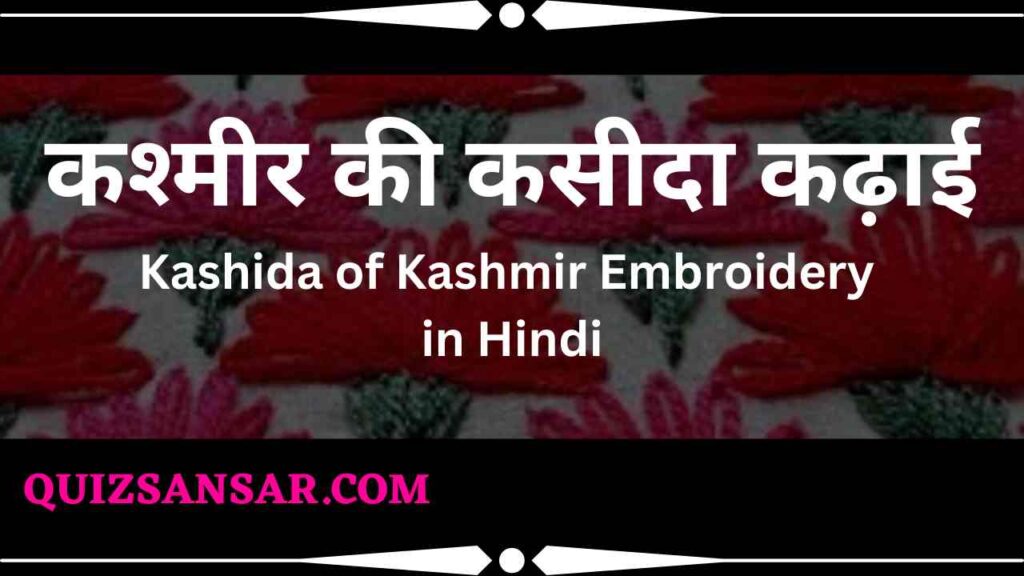

कश्मीर की कसीदा कढ़ाई पर संक्षिप्त टिप्पणी लिखिये।
कसीदा (Kashida)
कश्मीर कसीदा की कढ़ाई के लिए प्रसिद्ध था। कश्मीर की कढ़ाई का काम निर्यात के कारण बहुत विकसित हुआ था। कश्मीर की कढ़ी हुई ऊनी व पश्मीने की शॉल, साड़ी, नमदा आज भी देश-विदेश में बहुत लोकप्रिय है। कसीदा में साधारण टाँके, हेरिंग, बोन, चेन, उल्टी बखिया, साटिन, फंदे वाले टाँके प्रयोग किये जाते थे। कश्मीर की कढ़ाई के कारीगरों की विशेष उपलब्धि या गर्व का विषय है उनकी कसीदा कढ़ाई जो दोनों ओर एक से प्रतीत होते हैं। रेशमी वस्त्र पर रेशम तथा ऊनी वस्त्र पर रेशमी व ऊनी धागों का प्रयोग किया जाता था। इनमें नमूने वहीं की प्रकृति के चिनार के पत्ते, रंग-बिरंगी चिड़ियाँ, फलों-फूलों के गुच्छे का बाहुल्य रहता ‘था। कश्मीर की जमादार शॉल की तो कहीं भी कोई बराबरी नहीं कर सकता था।
प्रारम्भ में शॉल बनाने का काम लूम (Loom) पर होता था। परन्तु लूम के उपयोग पर टैक्स लग जाने से शॉल निर्माण कार्य हाथ से ही सम्पादित होने लगा। शॉल पर कढ़ाई के लिए पहले नमूने कागज पर छापे जाते थे। फिर उस नमूने को कोयले की पाउडर की सहायता से सादे शॉल पर उतारा जाता है। दारूखा (Darukha) नामक टाँके से कढ़ाई की जाती थी जिससे शॉल के दोनों तरफ एक से नमूने बनते थे। ‘दारूखा’ कढ़ाई इतनी बारीकी, सूक्ष्मता एवं सफाई से की जाती है थी कि शॉल का उल्टा एवं सीधा पक्ष पहचानना अत्यन्त कठिन हो जाता था। इस कढ़ाई से बना शॉल ऐसा प्रतीत होता था, मानो शॉल लूम पर तैयार किया गया हो
‘कश्मीर की कशीदा’ वहाँ के पुरुषों एवं युवाओं के द्वारा की जाती है। नमूने प्राकृतिक स्रोत (Natural Source) से लिये जाते हैं। कश्मीरी कढ़ाई कलाकार अपनी कलात्मकता, कुशाग्र बुद्धि, विलक्षण कल्पना-शक्ति एवं प्रवीण व जादुई अँगुलियों से प्रकृति का जीवंत चित्रण वस्त्र पर उतार देते हैं जिसे देखकर अचंभित हुए बिना नहीं रहा जाता।
कशीदा कढ़ाई वस्त्र के दोनों तरफ से एक समान रहती है। कढ़ाई में रंग-बिरंगे ऊनी एवं रेशमी धागों का प्रयोग किया जाता है। समस्त कढ़ाई एक समान सूक्ष्म, बारीक एवं महीन दिखती है। कहीं भी रूखड़ापन अथवा गाँठों का आभास नहीं होता है। नमूनों में फूलों के गुच्छे, फलों के गुच्छे, अंगूर के गुच्छे, चनार की पत्तियाँ, रंग-बिरंगी तितलियाँ, चिड़िया, विभिन्न प्रकार के पक्षियों, जैसे— मोर, तोता, वुडपेकर (कठफोड़वा), किंग फिशर (King fisher) आदि के चित्रों को अंकित किया जाता है। कश्मीर की कशीदा में मानव आकृतियों तथा पशुओं का चित्रण नहीं किया जाता है। इस कढ़ाई का सौन्दर्य, रंग-संयोजन, कलात्मकता अत्यन्त आकर्षक एवं अद्वितीय होता है। शॉल तथा स्कार्फो पर रफूगिरी की कढ़ाई अत्यन्त कुशलता एवं प्रवीणता से की जाती है।
कश्मीरी कढ़ाई में सफेद (Safed), बैंगनी (Vdu), पीला (Zarda), काला (Muskhi), नीला (Tizori), हरा (Zingari) आदि रंगों के धागे उपयोग में लिये जाते हैं। इसके अतिरिक्त (Scarlet or Kirmiz) तथा नारंगी (Gulnar) रंग भी काम में लाये जाते हैं।
कश्मीर का नमदा गलीचे के समान काम में लाया जाने वाला मोटा, फेल्ट किया हुआ वस्त्र है। इतने मोटे वस्त्र पर भी कश्मीरी कसीदाकार बहुत सुन्दर कढ़ाई करते हैं। इनमें ऊनी धागों का ही प्रयोग किया जाता है, जो अधिक चटक होते हैं। नमदा की कढ़ाई में केवल चैन स्टिच का प्रयोग होता है।
चटक रंगों के ऊनी धागों से नमूने काढ़े जाते हैं। इनमें चिनार की पत्तियों साथ सुन्दर रंग की सुकोमल टहनियाँ, फल-फूल, लताओं, पक्षियों आदि के नमूने बनाये जाते हैं। मूने बड़े-बड़े होते हैं जिससे सम्पूर्ण नमदा ही भर जाता है। शिकार बाग, बबुलदार, गुलदार, बादामदार आदि के चित्रों को भी कुशलतापूर्वक नमदे पर काढ़ा जाता है।
गब्बा या फिरन (Gabba) पूरे देश में लोकप्रिय है। यह सर्दियों के मौसम में पहना जाता हैं। गब्बे निम्न कोटि के ऊन से तैयार किये जाते हैं तथा सुन्दर नमूने से इसकी सजावट की जाती हैं।
आजकल भी कश्मीर में सुन्दर-सुन्दर नमूनों में शॉल, दरियाँ, नमदे, गब्बे आदि बनाये जाते हैं।
IMPORTANT LINK
- पटोला बुनाई कहाँ होती है? पटोला की रंग-बिरंगी साड़ी
- ड्रॉफ्टिंग किसे कहते हैं? ड्राफ्टिंग की विधि | What is drafting? method of drafting in Hindi
- सिलाई के सिद्धांत | principles of sewing in Hindi
- नाप लेते समय ध्यान देने योग्य बातें
- परिधान के लिए वस्त्र | FABRICS FOR CLOTHING IN HINDI
- शरीर का नाप लेने की आवश्यकता एवं विभिन्न नाप
- नाप लेने की विधि | measurement method in Hindi
- सिलाई मशीन की देखभाल अथवा मशीन के साधारण दोष एवं उनके निवारण का उपाय
Disclaimer: quizsansar.com does not own this book, PDF Materials Images, neither created nor scanned. The material and information contained on this website is for general information purposes only. If you have a complaint about something or find your content is being used incorrectly then kindly mail us: sansarquiz@gmail.com


लखनऊ की चिकनकारी कढ़ाई | Chikankari embroidery of Lucknow in Hindi
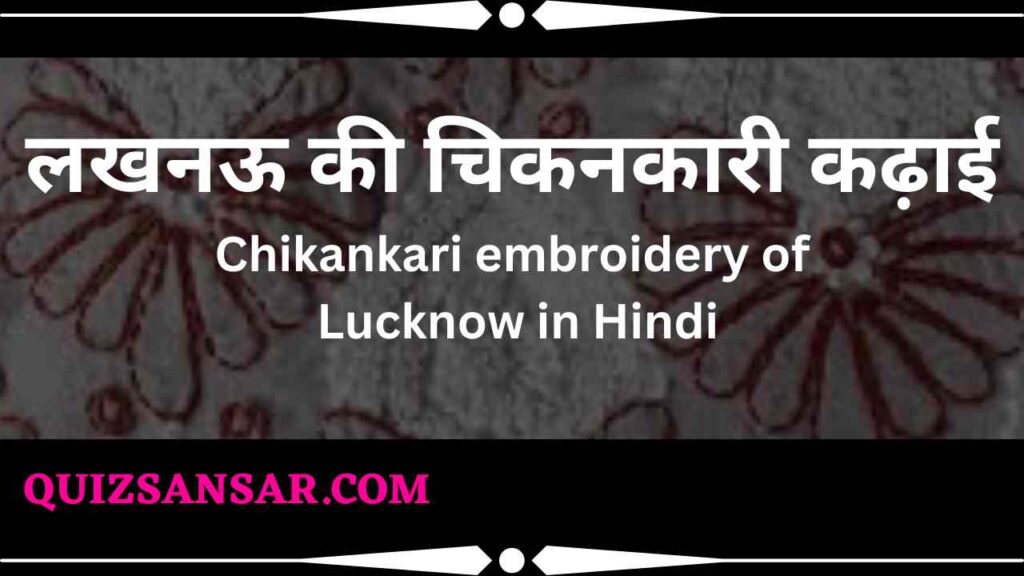

लखनऊ की चिकनकारी की विशेषता बताइये।
लखनऊ की चिकनकारी कढ़ाई (Chikankari embroidery of Lucknow)
उत्तर प्रदेश में ‘लखनऊ’ (Lucknow) ‘चिकनकारी’ (Chikankari) कढ़ाई के लिए सदा से ही प्रसिद्ध रहा है। यहाँ के चिकनकारी वस्त्र विश्वभर में प्रसिद्ध है। चिकनकारी कढ़ाई में ‘शैडो ‘काम’ (Shadow Work) किया जाता है।
चिकनकारी कढ़ाई अत्यन्त सूक्ष्म, बारीक एवं कोमल होती है। पहले यह केवल श्वेत मलमल के वसऊ पर श्वेत रेशमी धागों से ही बनायी जाती थी। परन्तु आजकल यह कढ़ाई अन्य वस्त्रों पर भी जैसे 2×2, कैम्ब्रे, औरगैन्डी, सिफॉन, जौरजेट, नेट, वायल आदि पर भी बनायी जाती है। इसमें विभिन्न प्रकार के रंगों के सूती एवं रेशमी धागों का भी इस्तेमाल किया जाता है।
चिकनकारी करने से पूर्व वस्त्र पर नमूने ट्रैस (छाप) कर लिये जाते हैं। नमूने प्राकृतिक स्रोत एवं घरेलू उपयोग की दैनिक वस्तुओं पर आधारित होते हैं, जैसे- चावल का दाना, गेहूँ की बाली, फूल, फल (आम), पशु, पक्षी, (मोर, तोता) इत्यादि ।
चिकनकारी में मुख्यतः साटिन (Satin), स्टेम (Stem), मूरी (Murri) तथा हेरिंग बोन (Herring bone) टाँके का उपयोग किया जाता है। बखिया एवं विभिन्न टाँकों की मदद से नमूने के अलग-अलग भाग को दर्शाया जाता है। बखिया एवं विभिन्न टाँकों की मदद से नमूनों के अलग-अलग भाग को दर्शाया जाता है। जाली टाँकों से चिकनकारी का काम अधिकतर साड़ियों पर किया जाता है। इसके अतिरिक्त पुरुषों के कुरते, टोपी, कफ, कालर, मेजपोश, दुपट्टे, सलवार कुर्ता, ब्लाउज आदि भी काढ़े जाते हैं। यह कढ़ाई पहले सफेद मलमल पर सफेद सूत या रेशम से ही की जाती थी। आजकल इसमें रंगों के कपड़े, धागे का भी प्रयोग किया जाता है।
चिकन की कढ़ाई मुख्यतः तीन प्रकार की होती है-
(1) चपटी (Flat)— बुखिया (Bukhia) और कटाओ (Katao) कढ़ाई चपटी प्रकार की हैं।
(2) गाँठदार (Knotted) या उभरी हुई— मुर्री (Murri) और फंदा गाँठदार या उभरी कढ़ाई के प्रकार हैं।
(3) जालीदार (Netting) – जाली की कढ़ाई वाले धागे खींचकर (Drawn thread) की कढ़ाई जैसी लगती है, परन्तु जाली बनाने की विधि भिन्न है।
जाली के कई प्रकार हैं— मद्रास जाली, कलकत्ता जाली आदि जो कि बहुत ही जटिल होती है। बुखिया कढ़ाई वास्तव में चिकनकारी है। यह कढ़ाई अत्यन्त जटिल है। डिजाइन के कपड़े के उल्टी तरह हेरिंग बोन (Hearring bon) टाँके से काढ़े जाते हैं, जो सफेद कपड़े के सीधी तरफ अपारदर्शक दिखाई देता है और डिजाइन के फूल, पत्ती के किनारों पर सादी बखिया (Back stitch) की भाँति छोटे-छोटे टाँके दिखाई देते हैं। इस कढ़ाई की तुलना वर्तमान काल की ‘शैडो वर्क’ (Shadow work) से की जा सकती है। कटाओ (Katao) कढ़ाई का प्रभाव बुखिया कढ़ाई के समान ही होता है।
मुरीं और फंदा का उपयोग डिजाइन में अनाज- चावल, गेहूँ, बाजरे के नमूने को काढ़ने के लिए किया जाता है।
नमूने प्रायः प्रतिदिन की साधारण वस्तुओं पर आधारित रहते थे, जैसे- – चावल का दाना, गेहूँ की बाली आदि। चिकनकारी के काम से साड़ियाँ, कुरते, सलवार, चुन्नी, मेजपोश टोकोजी, रूमाल आदि बनाये जाते हैं। आजकल इस कढ़ाई में हेरिंग बोन, शैडो वर्क आदि का अधिक प्रयोग होने लगा है। आधुनिक युग की चिनकारी में उस सूक्ष्मता, कोमलता व बारीकी का अभाव है, जो पहले देखने को मिलती थी।
IMPORTANT LINK
- पटोला बुनाई कहाँ होती है? पटोला की रंग-बिरंगी साड़ी
- ड्रॉफ्टिंग किसे कहते हैं? ड्राफ्टिंग की विधि | What is drafting? method of drafting in Hindi
- सिलाई के सिद्धांत | principles of sewing in Hindi
- नाप लेते समय ध्यान देने योग्य बातें
- परिधान के लिए वस्त्र | FABRICS FOR CLOTHING IN HINDI
- शरीर का नाप लेने की आवश्यकता एवं विभिन्न नाप
- नाप लेने की विधि | measurement method in Hindi
- सिलाई मशीन की देखभाल अथवा मशीन के साधारण दोष एवं उनके निवारण का उपाय
Disclaimer: quizsansar.com does not own this book, PDF Materials Images, neither created nor scanned. The material and information contained on this website is for general information purposes only. If you have a complaint about something or find your content is being used incorrectly then kindly mail us: sansarquiz@gmail.com


कढ़ाई के लिए आवश्यक सामग्री | Embroidery materials and tools in Hindi
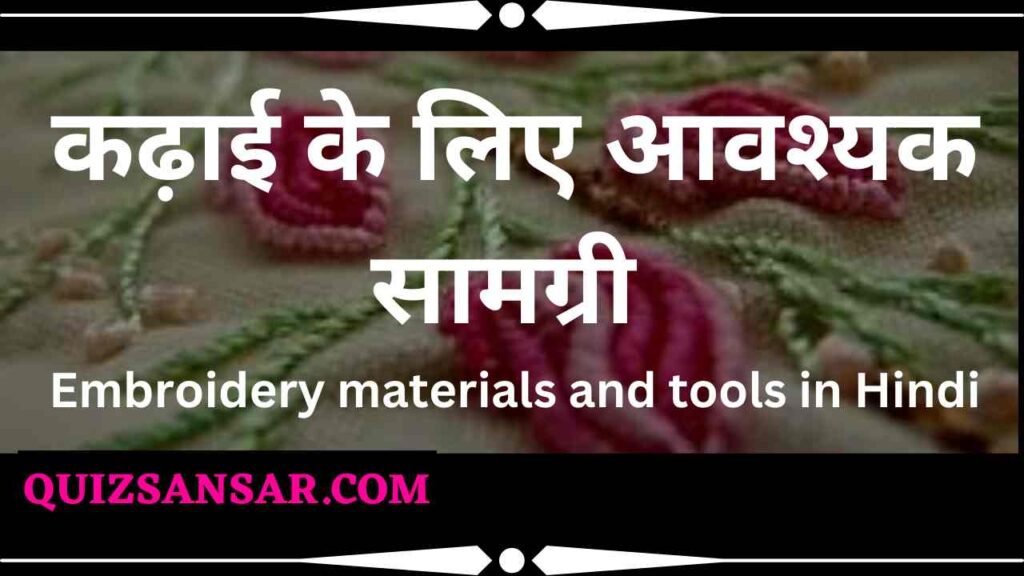

कढ़ाई के लिए आवश्यक सामग्री क्या क्या है?
कढ़ाई के लिए आवश्यक सामग्री
कढ़ाई हेतु निम्न सामग्री की आवश्यकता होती है-
1. मंजूषा (Work Box) –
कढ़ाई के लिए आवश्यक सामग्री सभी सामानों को एक साथ, एक जगह रखना चाहिए ताकि वे सरलता समय पर उपलब्ध हो सकें। इसके लिए किसी ढक्कन वाले बड़े डिब्बे, टोकरी अथवा हाथ से बनाई गई मंजूषा का उपयोग किया जा सकता है। आजकल बाजारों में प्लास्टिक की सुन्दर, रंगीन, पारदर्शी मंजूषाएँ मिलती हैं। इनके भीतर ही धागे, सुइयाँ, कैंची रखने के स्थान विभाजित रहते हैं। इनका उपयोग भी किया जा सकता है।
2. धागे (Threads) —
कढ़ाई के लिए सूती तथा रेशमी धागों की लच्छियाँ उपयोग में लाई जाती हैं। मंजूषा में प्राथमिक रंगों (Basic Colours) तथा काले, सफेद रंगों की लच्छियाँ अवश्य रखें। लाल, पीली, नीली प्राथमिक रंगों की लच्छियों के अतिरिक्त आवश्यकतानुसार अलग-अलग रंगों के शेड्स की लच्छियाँ भी रखें। रेशमी, सूती तथा ऊनी कपड़े पर उसी तंतु से बनी लच्छियों का उपयोग करें। इससे धागों का तनाव एक-सा रहता है तथा कढ़ाई अधिक सुन्दर दिखाई देती है।
अधिकतर बाजार में उपलब्ध प्रत्येक रंग की लच्छी में छः धागे (तार) होते हैं। कढ़ाई के नमूने के अनुसार आवश्यक प्रभाव उत्पन्न करने के लिए छः, तीन या दो धागों (तारों) से कढ़ाई की जाती है। कभी-कभी इकहरा धागा भी प्रयोग लाया जाता है। चाहे किसी भी प्रकार का धागा प्रयुक्त करें, किन्तु एक बात अवश्य ध्यान में रखनी चाहिए कि धागों का रंग पक्का हो।
3. सुइयों (Needles)—
कढ़ाई करने की सुइयाँ लम्बी, छोटी, महीन, मोटी आदि विभिन्न आकारों, प्रकारों की होती हैं तथा आवश्यकतानुसार प्रयोग में लाई जाती है। ऊन की सुई मोटी और कम नुकीली होती है। इससे मोटे ऊनी कपड़े, कैनवास (Canvas) या जाली (Net) पर कढ़ाई की जाती है।
कढ़ाई के लिए उपयोग में आने वाली सुई बहुत अच्छी होनी चाहिए। इसकी जाँच करने हेतु सुई को हाथ में लेकर अँगुलियों से दबाएँ। सुई यदि कच्ची धातु की बनी होगी तो दबाने से टेढ़ी हो जाएगी अथवा टूट जाएगी। इस प्रकार की सुई का प्रयोग न करे। उसी का छेद गोल हो या लम्बा, धागे की मोटी से कुछ बड़ा और चिकना होना चाहिए। छेद खुरदरा हने से धागा डालने में असुविधा होती है, साथ ही कढ़ाई करते समय धागे के फँसने अथवा टूट जाने का भय रहता है।
सुई को भीगे हाथों से न छुएँ। सुइयों को सदा साफ, चिकनी तथा जंग रहित रखें। इसके लिए सुइयों पर तेल सगड़ दें या सुई की डिब्बी में पाउडर छिड़कर उसमें सुइयाँ रखें।
4. अंगुश्तान (Thimble)-
कढ़ाई करते समय बार-बार सुई ठेलने से अँगुली में छेद न हो इसलिए अंगुश्तान पहना जाता है। अंगुश्तान धातु या प्लास्टिक का होता है। इसे सही नाप का और चिकना होना चाहिए। अंगुश्तान दाहिने हाथ की मध्यमा (मध्य अँगुली) में पहना जाता है। फ्रेम पर काम करते समय बाएँ हाथ की मध्य अँगुली में भी पहना जा सकता है।
5. कैंचियाँ (Scissors) —
कपड़ा काटने के लिए बड़ी तथा धागा काटने के लिए छोटी कैंची का उपयोग किया जाता है। कटवर्क अथवा अन्य महीन कटाई हेतु अच्छी नोक वाली कैंची की आवश्यकता होती है। कैंचियाँ मजबूत धातु की तीक्ष्ण धार वाली होनी चाहिए।
6. फ्रेम (Frame) –
किसी भी नमूने को सफाई से काटने के लिए फ्रेम का उपयोग किया जाता है। अधिक अभ्यस्त हाथों को फ्रेम की आवश्यकता नहीं होती। जब किसी नमूने में पास-पास कई प्रकार के टाँके प्रयोग में लाये जाये हैं तब नमूना स्पष्ट दिखाई दे, कपड़े में सिकुड़न न पड़ने पाये और सफाई से काम हो सके, इन उद्देश्यों की पूर्ति हेतु फ्रेम का उपयोग करते हैं।
अधिक प्रचलित गोल फ्रेम होते हैं जो धातु अथवा लकड़ी द्वारा निर्मित होते हैं। ये छोटे- बड़े कई प्रकार के होते हैं। इसमें दो छल्ले होते हैं। छोटे छल्ले पर नमूने वाला भाग रखकर उस पर बड़ा छल्ला लगाते हैं। फिर सभी ओर से कपड़े को खींचकर, सीधा करके, बड़े छल्ले पर लगा हुआ नट कस दिया जाता है।
बड़े नमूने या प्राकृतिक दृश्य वाले बड़े चित्रों पर कढ़ाई करते समय फ्रेम का उपयोग किया जाता है।
7. कार्बन पेपर (Carbon Paper) –
कार्बन पेपर लाल, गुलाबी, पीले, जामुनी तथा काले रंगों में मिलता है। यह कागज डिजाइन को कपड़े पर उतारते समय काम में लाया जाता है। कार्बन अच्छी किस्म का होना चाहिए जिससे उसका रंग कपड़े पर न लगे।
8. पेंसिल (Pencil)—
ट्रेसिंग पेपर पर नमूना उतारने के लिए अथवा कार्बन पर से नमूना ट्रेस करने के लिए नोकदार, कड़ी पेंसिलें काम में लाई जाती है।
9. ट्रेसिंग कागज (Tracing Paper)—
पतले, पारदर्शी ट्रेसिंग पेपरों का उपयोग पुस्तकों अथवा पत्रिकाओं से नमूने उतारने एवं पुनः कार्बन की सहायता कपड़े पर उतारा जाता है। कुछ नमूनों के पीछे कार्बन वाली स्याही लगी होती है। उन नमूनों को कपड़े पर रखकर, ऊपर से मार्किंग ह्वील चला देने से नमूना कपड़े पर उतर आता है। पेंसिल की तुलान में मार्किंग हील की सहायता से कार्य शीघ्रतापूर्वक सम्पन्न होता है।
10. मार्किंग ह्वील (Marking Wheel)-
इसे ‘ट्रेसिंग ह्वील’ या नमूना उतारने का गाठिया भी कहते हैं। बड़ी-बड़ी डिजाइनों को मार्किंग हील की सहायता से कपड़े पर उतारा जाता है। कुछ नमूनों के पीछे कार्बन वाली स्याही लगी हती है। उन नमूनों को कपड़े पर रखकर ऊपर से मार्किंग ह्वील चला देने से नमूना कपड़े पर उतर आता है। पेंसिल की तुलना में मार्किंग ह्वील की सहायता से कार्य शीघ्रतापूर्वक सम्पन्न होता है।
11. पिनें (Pins)—
कपड़ा, कार्बन एवं नमूने वाले कागज को यथास्थान बनाये रखने के निमित्त पिनों की आवश्यकता पड़ सकती है, अतः सिलाई के डिब्बे में एक पिन मंजूषा (Pin Box) रखना भी जरूरी है।
12. टेलर्स चॉक Chalk)-
कपड़े पर निशान लगाने के लिए टेलर्स चॉक का उपयोग भी किया जाता है।
13. मापने का फीता (Measuring Tape)-
कपड़े की लम्बाई, चौड़ाई, नमूने की दूरी इत्यादि अंकित करने के लिए नापने के फीते का प्रयोग करना चाहिए।
14. नमूने तथा नमूनों की पुस्तिका (Design or Design Book)-
विभिन्न प्रकार के वस्त्रों पर काढ़ने के लिए तत्काल नमूना ढूँढ़ने में कठिनाई न हो, इस परेशानी से बचने के लिए सिलाई मंजूषा में कई तरह के नमूने एकत्र करके अथवा नमूनों की पुस्तिका अवश्य रखें। विभिन्न टाँकों, एपलीख वर्क, काट वर्क एवं क्रॉस स्टिच से बनये जाने वाले सभी प्रकार के नमूने संग्रहित करें। बाजार में नमूनों की पुस्तिकाएँ मिलती हैं। पत्र-पत्रिकाओं में भी नमूने प्रकाशित होते रहते हैं। इसके अतिरिक्त आप ट्रेसिंग पेपर्स जोड़कर एक पुस्तिका बना सकती हैं। इसमें अच्छे नमूने संकलित करती जाएँ।
IMPORTANT LINK
- पटोला बुनाई कहाँ होती है? पटोला की रंग-बिरंगी साड़ी
- ड्रॉफ्टिंग किसे कहते हैं? ड्राफ्टिंग की विधि | What is drafting? method of drafting in Hindi
- सिलाई के सिद्धांत | principles of sewing in Hindi
- नाप लेते समय ध्यान देने योग्य बातें
- परिधान के लिए वस्त्र | FABRICS FOR CLOTHING IN HINDI
- शरीर का नाप लेने की आवश्यकता एवं विभिन्न नाप
- नाप लेने की विधि | measurement method in Hindi
- सिलाई मशीन की देखभाल अथवा मशीन के साधारण दोष एवं उनके निवारण का उपाय
Disclaimer: quizsansar.com does not own this book, PDF Materials Images, neither created nor scanned. The material and information contained on this website is for general information purposes only. If you have a complaint about something or find your content is being used incorrectly then kindly mail us: sansarquiz@gmail.com
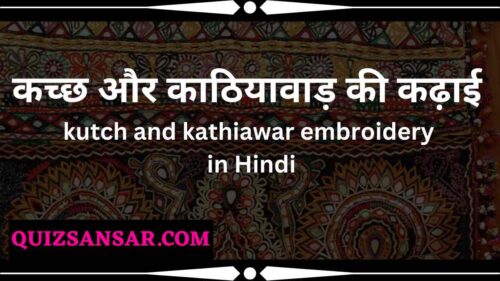

कच्छ और काठियावाड़ की कढ़ाई | kutch and kathiawar embroidery in Hindi


सिन्ध / कच्छ / काठियावाड़ की कढ़ाई किसे कहते है?
कच्छ/ काठियावाड़ की कढ़ाई (kutch and kathiawar embroidery)
कच्छ और काठियावाड़ की कढ़ाई व सिन्ध की कढ़ाई में बहुत समानता है। सिन्ध की कढ़ाई पर पंजाब व बिलोचिस्तान की कढ़ाई का बहुत प्रभाव है। पंजाब की फुलकारी के टाँकों व सिन्ध की फुलकारी के चेन टाँकों के सम्मिश्रण से तैयार सिन्ध कढ़ाई का अपना एक विशिष्ट सौन्दर्य होता है। इनमें टाँकें तो सादे ही होते हैं, परन्तु शीशे के नन्हें टुकड़ों का प्रयोग बहुत अधिक होता है, सिन्ध में शीशे के टुकड़ों को बटन होल (Button hole) टाँके से लगाया जाता है, लेकिन कच्छ और काठियावाड़ में चेन के टाँके (Chain Stitch) से लगाया जाता है। इनमें हाथियों, छतरियों, मोरों और तोतों के मोटिफ (Motif) काढ़े जाते हैं। हाथ से बुने कत्थई रंग के कपड़े पर नारंगी, काले तथा बैंगनी रंग के धागों से कढ़ाई की जाती थी। इस कढ़ाई को ‘कान्ची’ कहा जाता था। इस कढ़ाई से लहँगे, चोली आदि वस्त्र काढ़े जाते थे। कढ़ाई कच्चे सिल्क धागों तथा सूती धागों से होती थी।


काठियवाड़ की कढ़ाई में कच्छ एवं सिन्ध की कढ़ाई का सुन्दर सम्मिश्रण रहता था। इनमें शीशे के नन्हें टुकड़ों को भी लगाया जाता था। चेन तथा साटिन टाँके अधिक लोकप्रिय थे। हल्के रंग, स्पष्ट नमूने इसकी विशेषता थी। इस कढ़ाई से लहँगे, चोली सुसज्जित किये जाते थे ।
काठियावाड़ की कढ़ाई (Kathiawar Embroidery)
काठियावाड़ की कढ़ाई पंजाब की फुलकारी एवं सिन्ध की कढ़ाई से मिलती-जुलती है। इसमें ‘काँच वर्क’ (Mirror work) काँछ के नन्हें टुकड़ों का बाहुल्य रहता है। काँच के टुकड़े को काज टाँके (Buttonhole Stitch) से लगाया जाता है।
त्रिकोण के बीच में काँच के नन्हें टुकड़ों को काज टाँके से सजाया जाता है। दोनों आमने-सामने के त्रिकोणों को लम्बे टांके (Long Stitch) से भराई जाती है, परन्तु यह ध्यान रखना आवश्यक होता है कि कढ़ाई में धागे बिल्कुल सीधे एवं आड़े हों।
अबला भारत के प्रकार का ‘मिरर वर्क’ ही है। इसमें काँछ के टुकड़ों के द्वारा वस्त्र को अत्यन्त सुन्दर एवं आकर्षक बनाया जाता है। यह काठियावाड़ का पारम्परिक कढ़ाई कला का एक अभिन्न हिस्सा है। परन्तु आजकल इसका प्रचार-प्रसार अत्यन्त व्यापक हो गया है। राजस्थानी कढ़ाई में भी अबला भारत (Mirror work) का बाहुल्य रहता है। आजकल देश के अन्य भागों में भी शीशे के नन्हें टुकड़ों से वस्त्र को अलंकृत किये जाने लगे हैं। चटकीले रंग के रेशमी धागों से अबला भारत का काम किया जाता है। नमूने में फूल-पत्तियों, मोर, तोता, पशु, लताएँ आदि के चित्र काढ़े जाते हैं।
गुजरात ‘बीड वर्क’ (Bead work) के लिए भी काफी प्रसिद्ध है। इसमें कढ़ाई के द्वारा सुन्दर-सुन्दर ‘बीड्स’ (Beads) बनाकर वस्त्र को अलंकृत किया जाता है। सफेद वस्त्र पर रंग- बिरंगे मोती जैसे बीड्स लगाये जाते हैं। इसमें विशिष्ट नमूने नहीं काढ़े जाते हैं बल्कि हाथी, घोड़े, तोते, मोर, गाय-बछड़ा आदि के नमूने को सुन्दर ढंग से काढ़ा जाता है। हालांकि बीड से अलंकृत परिधान ज्यादा उपयोगी नहीं होते हैं परन्तु इनसे सजावटी समान, जैसे- तोरण द्वार, थैले, पर्स, कुशन कवर, सोफा कवर, दीवारों पर लटकाने वाले चित्र, खिलौने आदि तैयार किये जाते हैं।
IMPORTANT LINK
- पटोला बुनाई कहाँ होती है? पटोला की रंग-बिरंगी साड़ी
- ड्रॉफ्टिंग किसे कहते हैं? ड्राफ्टिंग की विधि | What is drafting? method of drafting in Hindi
- सिलाई के सिद्धांत | principles of sewing in Hindi
- नाप लेते समय ध्यान देने योग्य बातें
- परिधान के लिए वस्त्र | FABRICS FOR CLOTHING IN HINDI
- शरीर का नाप लेने की आवश्यकता एवं विभिन्न नाप
- नाप लेने की विधि | measurement method in Hindi
- सिलाई मशीन की देखभाल अथवा मशीन के साधारण दोष एवं उनके निवारण का उपाय
Disclaimer: quizsansar.com does not own this book, PDF Materials Images, neither created nor scanned. The material and information contained on this website is for general information purposes only. If you have a complaint about something or find your content is being used incorrectly then kindly mail us: sansarquiz@gmail.com


भारत की परम्परागत कढ़ाई का परिचय एंव फुलकारी के प्रकार


भारत की परम्परागत कढ़ाई का परिचय देते हुये फुलकारी का वर्णन कीजिये।
वस्त्रों को कढ़ाई द्वारा सजाया जाता है। कढ़ाई किये हुए वस्त्रों के लिए भी भारत सदैव प्रसिद्ध रहा है। वैदिक काल के साहित्य में भी इनका उल्लेख मिलता है। मुगलों तथा पहाड़ी जातियों में कढ़ाई स्त्रियाँ और पुरुष दोनों करते थे। पहाड़ी महिलाएँ काढ़ने में विशेष निपुण थीं। अब मशीनों से भी अत्यन्त सुन्दर डिजायन काढ़े जाते हैं। हमारे यहाँ साधारण कपड़ों के अतिरिक्त अन्य पदार्थों पर भी हाथ से कढ़ाई की जाती है, जैसे― चमड़े, जाली, मखमल व रेशम पर। कढ़ाई के लिए सूती, ऊनी व रेशमी धागों के अतिरिक्त मोती, अबरक, सोने-चाँदी के तारों से बने धागे भी प्रयोग में लाये जाते हैं। अन्य देशों में कोई भी कढ़ाई का ऐसा टाँका न होगा जो भारत के कारीगर प्रयोग में न लाते हों।
भारतीय कारीगर प्रकृति से बहुधा प्रेरणा प्राप्त करता है और अपनी कला में उसे ही चित्रित करता हहै, जैसे- हाथी, मोर, आम, कमल का फूल। कश्मीरी कारीगर, कश्मीर के चिनार के पेड़ का पत्ता, चैरी (Cherry), केसर का फूल, तोता, रामचिरैया (King Fisher), कठफोड़वा (Wood-poker) आदि को उनके प्राकृतिक रंगों में काढ़ता है।
कढ़ाई कार्य अधिकतर सिल्क के वस्त्रों पर किये जाते थे। नमूने के रूप में प्राकृतिक सौन्दर्य का चित्रण, पशु-पक्षी, नृत्य करती मानव आकृतियाँ, देवी-देवताओं के चित्र, पौराणिक गाथाओं पर आधारित चित्र काढ़े जाते थे। रंग-बिरंगे रेशमी एवं सूती धागों से वस्त्र को काढ़ा जाता था।
कढ़े वस्त्रों का उपयोग शादी-विवाह, तीज-त्योहार, विशेष उत्सवों एवं नाटक खेलने में किया जाता था।
भारत की कुछ प्रसिद्ध फुलकारी कढ़ाई निम्नलिखित हैं-
1. पंजाब की पुलवारी – पंजाब के जाट लोगों द्वारा यह कार्य विशेष रूप से किया जाता था। यह पंजाबियों की एक महत्त्वपूर्ण परम्परागत कढ़ाई है। पंजाब की फुलकारी देश- विदेशों में प्रसिद्ध है। रोहतक, गुड़गांव, करनाल, हिंसार और दिल्ली फुलकारी के काम के लिए काफी प्रसिद्ध हैं पश्चिमी पंजाब में फूलकारी के ‘बाग’ कहा जाता है। बाग फुरकारी का ही एक विस्तृत रूप है। इसमें पूरे वस्त्र पर “फूलकारी” की जाती है जिससे सम्पूर्ण वस्त्र एं “बाग” की तरह प्रतीत होने लगता है।
फुलकारी का काम पंजाबी लड़कियों एवं स्त्रियों द्वारा बढ़ने ही उल्लास एवं उत्साह से किया जाता है। यह उनका उद्यमी, पश्चिमी एवं कठिन, मेहनती होए का संकेत देता है। फुलकारी को सुख, समृद्धि ऐश्वर्य एवं सुहाग का प्रतीक माना जाता है। इसलिए फूलकारी से कड़े परिधानों को वहां की विवाहित स्त्रियाँ बड़े ही उल्लास | उत्साह के साथ शादी विवाह एवं तीज-त्यौहारों के अवसर पर पहनती हैं।
फुलकारी का काम साधारण खहर के वस्त्र पर किया जाता हैं सिल्क धागों से इस पर जयामितीय नमूने बनाये जाते हैं। इसमें सीधी, तिरछी, आड़ी चौकोर एवं त्रिकोण रेखाओं का उपयोग किया जाता है। इनमें लाल, पीला, नारंगी एवं सफेद रंगों का प्रयोग किया जाता है। फुलकारी अत्यन्त सौन्दर्य एवं आकर्षक लगता है। इसे माँ अपनी पुत्री को शादी के शुभ अवसर पर उपहार स्वरूप देती है।
फुलकारी के प्रकार (Types of Phulkari)
फुलकारी कई प्रकार की होती है। कुछ अत्यन्त लोकप्रिय एवं महत्त्वपूर्ण फुलकारी निम्नलिखित हैं-
1. चोप (Chope) – चोल लाल रंग के चद्दर पर बना होता है। जिसे नारी अपने नातिन की शादी के अवसर पर उपहार स्वरूप देती है। यह सुनहरे पीले रंग के रेशमी धागों से दोहरी टकाई के टांके (double Running Stitch) से बनाये जाते हैं। कढ़ाई वस्त्र के दोनों ओर से दिखाती है।
2. सुभर (Subhar)- यह शॉल भी चप की तरह लाल रंग के शॉल पर बना होता है। इसे माँ पुत्री के शादी के शुभ अवसर पर उपहार स्वरूप देती है। इसे ‘फेरा’ के समय पहना जाता है।
3. तिलपन्ना (Tilpatra) – ये सस्ते एवं झिरझिरे खद्दर के वस्त्रों पर बनाये जाते हैं। इसमें छोटे-छोटे फूलों के नमूने बने होते हैं। इसे गृह स्वामी अपनी दासियों को शादी के शुभ अवसर पर उपहार स्वरूप देती है।
4. शीशेदार फुलकारी (Shishedar Phulkari ) – इस फुलकारी के नमूनों के बीच- बीच में शीशे या अभ्रक के टुकड़ों को काज वाले टांके से लगाया जाता है। यह फुलकारी साटन तथा रेशणी वस्त्रों पर किया जाता है।
5. कच्छ की फुलकारी (Kuchh Phulkari ) – कच्छ की फुलकारी काफी लोकप्रिय एवं प्रसिद्ध है। कच्छ प्रदेश में किये जाने के कारण इसका नाम भी कच्छ फुलकारी पड़ा है इसमें वस्त्र के चारों ओर उत्कृष्ट नमूने से बार्डर बनाया जाता था। बीच में रिक्त स्थानों में पशु-पक्षी, फल-फूल, पत्तियाँ, हाथी, मोर, तोते, हंस, कबूतर आदि के नमूने बनाये जाते थे। नमूने प्रायः चैन एवं हेरिंग बोन टांके से बनाये जाते हैं।
IMPORTANT LINK
- पटोला बुनाई कहाँ होती है? पटोला की रंग-बिरंगी साड़ी
- ड्रॉफ्टिंग किसे कहते हैं? ड्राफ्टिंग की विधि | What is drafting? method of drafting in Hindi
- सिलाई के सिद्धांत | principles of sewing in Hindi
- नाप लेते समय ध्यान देने योग्य बातें
- परिधान के लिए वस्त्र | FABRICS FOR CLOTHING IN HINDI
- शरीर का नाप लेने की आवश्यकता एवं विभिन्न नाप
- नाप लेने की विधि | measurement method in Hindi
- सिलाई मशीन की देखभाल अथवा मशीन के साधारण दोष एवं उनके निवारण का उपाय
Disclaimer: The content Published on this Website is made for informational and educational purposes only. If you have a complaint about something or find your content is being used incorrectly then kindly mail us: sansarquiz@gmail.com
